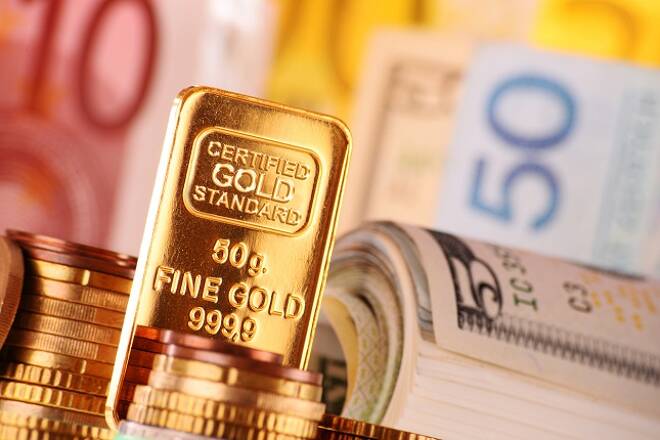Advertisement
Advertisement
Will Sputtering Global Growth and the Just-Announced Brexit Deal Support Gold?
By:
3 percent – that’s the new IMF global growth forecast for 2019. It’s the lowest one since the Great Financial Crisis. Is the much talked about recession coming? And what about the just reached Brexit deal? Can they both make gold rally?
The October edition of the World Economic Outlook, the flagship publication of the International Monetary Fund, is out! The organization forecasts the global growth at 3.0 percent in 2019, the lowest level since the Great Recession, and a 0.3 percentage point downgrade from the April’s World Economic Outlook. In particular, momentum in manufacturing activity has weakened substantially, not only in the U.S. but all over the world.
According to the IMF, the weakening of industrial output and overall economic activity was caused mainly by three factors. First, weak business confidence amid intensifying trade war between the United States and China. Second, a slowdown in demand in China, driven both by the trade tensions and by the regulatory efforts to rein in debt. Third, a significant downturn in car production and sales, caused by reduced China’s demand, but also by new emission standards and supply disruptions.
Although the IMF does see a pickup in growth in 2020 and beyond, there is an elephant in a room. The disturbing fact is that the subdued world growth of 3 percent is occurring at a time when monetary policy has significantly eased almost simultaneously across advanced and emerging markets. Without another round of monetary stimulus, the global growth would be 2.5 percent this year, which is a recessionary threshold for the global economy. In other world, the world economy is like a patient under medical ventilator – unable to breathe on his own, and kept alive by the doctors. Bad news for the humanity, good news for gold!
U.S. Goes Down, Euro Area Goes Up
And what about the United States? Growth in 2019 is expected to be 2.4 percent, a decline from 2.9 percent in 2018. And what is even more important, that growth is forecasted to moderate to 2.1 percent in 2020. The projected slowdown is caused by the waning effects of the fiscal stimulus adopted in a recent two-year budget deal. Actually, the worsening may be even worse, as the IMF is always a bit too optimistic and it assumes that the Fed’s recent interest rate cuts will stimulate the economy, which is far from being certain.
What is more, the economic activity in the euro are is expected to pick up from very weak 1.2 percent in 2019 (drop from 1.9 percent in 2018) to 1.4 percent in 2020, as external demand is projected to regain some momentum, while some temporary factors (Germany’s car industry issues spring to mind) continue to fade. The simultaneous acceleration in the euro are and deceleration in the U.S. should weaker the dollar against the euro. One less worry for gold!
Implications for Gold
The world’s economy slowed down to mere 3 percent. One could say that it should be supportive for the gold prices, but the yellow metal reacts mainly to the developments in the U.S. economy. Luckily for the bullion, the American engine is likely to slow down in 2020, which could weaken the greenback, while supporting gold prices.
The gloomy IMF’s outlook means that the time for jokes is over, there is no room for policy mistakes. Policymakers should cooperatively deescalate trade and geopolitical tensions. And it seems that they took the first step. Today’s breaking news is that the EU and the UK reached an agreement on Brexit. It should reduce the uncertainty in the markets and weaken the safe-haven demand for gold. But on the other hand, the deal should help both the UK and the euro area, which could help the gold prices. Indeed, as the chart below shows, the euro soared immediately against the U.S. dollar.
Chart 1: EUR/USD exchange rate on October 17, 2019.
As the news came when this article was almost finished, we will bring you the full analysis of the Brexit deal and upcoming reactions in the future editions of the Gold News Monitor. The deal still has to pass through the UK Parliament, so stay tuned!
If you enjoyed the above analysis, we invite you to check out our other services. We provide detailed fundamental analyses of the gold market in our monthly Gold Market Overview reports and we provide daily Gold & Silver Trading Alerts with clear buy and sell signals. If you’re not ready to subscribe yet and are not on our gold mailing list yet, we urge you to sign up. It’s free and if you don’t like it, you can easily unsubscribe. Sign up today!
Disclaimer: Please note that the aim of the above analysis is to discuss the likely long-term impact of the featured phenomenon on the price of gold and this analysis does not indicate (nor does it aim to do so) whether gold is likely to move higher or lower in the short- or medium term. In order to determine the latter, many additional factors need to be considered (i.e. sentiment, chart patterns, cycles, indicators, ratios, self-similar patterns and more) and we are taking them into account (and discussing the short- and medium-term outlook) in our trading alerts.
Thank you.
Arkadiusz Sieron
Sunshine Profits‘ Gold News and Gold Market Overview Editor
About the Author
Arkadiusz Sierońcontributor
Arkadiusz Sieroń, Ph.D., is an Assistant Professor at University of Wrocław. He is a certified Investment Adviser and a long-time precious metals market enthusiast.
Advertisement
